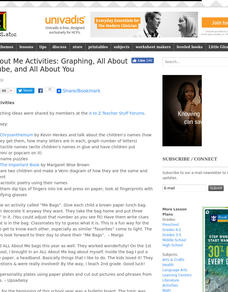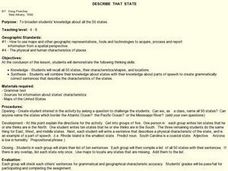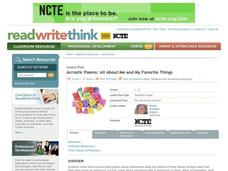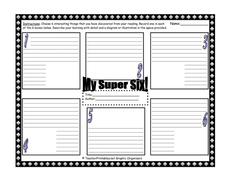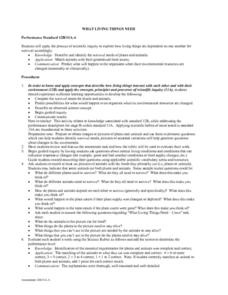Curated OER
All About Me
This is an awesome resource for any elementary or middle school teacher about to start a new school year! This resource includes an extensive list of activities for introducing the members of your class to each other. Some of the ideas...
Curated OER
Classifiers
Classifiers help describe things in American Sign Language. Provide your class with a visual image for each classifier, and then use this presentation as a review tool. Finally have learners put their knowledge to use by selecting...
Curated OER
Dr. Seuss For a Day
Second graders brainstorm words to describe Thing One and Thing Two characters from Dr. Seuss computer program, use variety of adjectives to create descriptions, and create new set of characters, Thing Three and Thing Four, by drawing...
Curated OER
Describe That State
Students broaden knowledge about all the 50 states. They combine their knowledge about states with their knowledge about parts of speech to create grammatically correct sentences that describe the characteristics of the states.
Columbus City Schools
Diversity of Living Things
Here's a topic classes can really dig—the fossil record. Use the well-organized and thoughtful road map to take eighth graders back in time to unearth the answer. Learn how our climate has changed, and how organisms have...
DiscoverE
Product Dissection
Sometimes, taking things apart is more fun than putting things together. Groups of learners participate in a reverse engineering activity. They dissect a device of their choosing to see how it works—great hands-on learning from the...
National Council of Teachers of English
Acrostic Poems: All About Me and My Favorite Things
Budding poets create two acrostic poems, one for their name and another using a word of their choice. Over the course of five days, scholars compose, revise, publish, and share their work with their peers.
Curated OER
Interactions of Living Things
Is it a producer, carnivore, omnivore, scavenger, or decomposer? Different relationships among organisms are explored here. It is a simple, multiple choice assignment. Use it as a quick warm-up or quiz.
Curated OER
My Planet Earth
The earth is a delicate and fragile thing; Why not engage your class in a craft project that will make them aware of our environment? Earth Day is celebrated as recycled materials are used to create earth window hangings. Crayons are...
Curated OER
Who Am I?
Get to know a person in your class or a famous figure in history. With questions about the person's birthplace, parents, and what they are famous for. A space at the bottom prompts writers to list three things they have learned.
Do2Learn
Journal Writing
Ask learners to keep a basic journal of any number of things with this graphic organizer. Kids write in a topic and write down four events, responding to the prompts in above each box.
Anglophone School District
Fluids: Force in Fluids
Discuss Archimedes' Principle and fluid forces with your young scientists as they describe the relationship between mass, volume, and density during a series of engaging activities. They use the Participle Theory of Matter to explore the...
Freeology
Never Say Can't Poster
Eliminate doubt and illuminate possibility with a clever classroom sign. A red circle slashes out the word, making your class the place where kids might try new things.
Academy of American Poets
Teach This Poem: “As I Walk These Broad Majestic Days” by Walt Whitman
Walt Whitman's poem "As I Walk These Broad Majestic Days" offers scholars an opportunity to practice their noticing skills. They first examine a postcard of the Newport News Shipyard listing things they notice about the image and how...
Curated OER
Habitat
Young scholars are able to define habitat. They are able to identify the four things that living things need to survive. Students are able to describe how living things are adapted to their habitats.
Curated OER
Monster Voices
Students create stories based upon the techniques of author Maurice Sendak in Where the Wild Things Are. They use a word processing program and the Apple software program GarageBand to create new voices for the story. ...
Curated OER
Classifying Living and Non-Living Objects
Students investigate living organisms and define the properties of a living species. For this life characteristic lesson, students examine plants in their class and discuss whether or not they are alive. Students create a...
Curated OER
Vegetable Twister
Second graders study the changes in organisms over time. In this Life Science lesson, 2nd graders explore how living things react to changes in the environment. Students identify the basic needs of living things.
Curated OER
Preposition House
Identify and use prepositions to describe how objects relate to one another. Each child draws a house and then draws items in, around, on, and under the house to demonstrate different prepositions. Written descriptions accompany their...
K12 Reader
Animal Adjectives
How would you describe someone who was acting like a dog or a chicken? Teach your class the adjectives that pair with 20 different animals. They'll be able to describe anything canine or crocodilian, and everything in between.
Alabama Learning Exchange
Nature's Life Cycle
Become a member of the Pollution Patrol and stand up to litter! After discussing the life cycle of seeds and discussing how plants figure into the food chain, young conservationists engage in several activities involving podcasts,...
Teacher Printables
My Super Six
As pupils read a text, have them fill out six things than stand out on this sheet. There is a space for pupils to fill in a title and author as well as six separate boxes with lines and space for a diagram or illustration.
Curated OER
Pride and Prejudice: Biopoem
Describe yourself or a character from Jane Austen's Pride and Prejudice with a biopoem activity. Using the provided format, kids write their own characteristics or the character traits from the novel to create a poetic portrait.
Curated OER
What Living Things Need
Students apply the process of scientific inquiry to explore how living things are dependent on one another for survival. They match animals with their generalized food source. Students predict what happens to the organisms when their...
